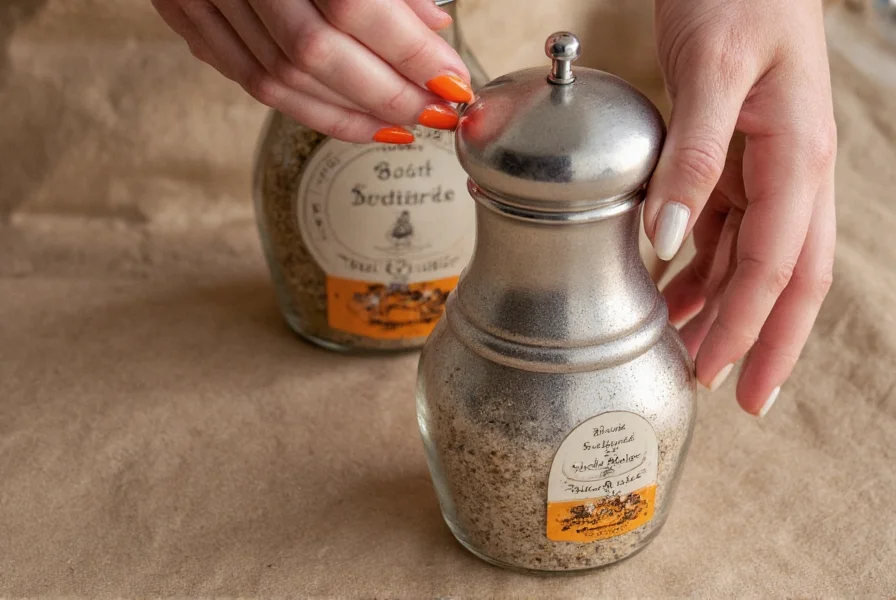Understanding why salt and pepper need dedicated mills begins with their distinct physical properties. Salt, particularly sea salt and other coarse varieties, contains moisture and chloride compounds that corrode metal components over time. This corrosion leads to seized mechanisms and compromised grinding performance. Pepper, meanwhile, contains natural oils that can gum up mechanisms not designed to handle them.
The Science Behind Salt and Pepper Mill Design
Mill manufacturers design specialized mechanisms based on the unique characteristics of each seasoning. The key differences stem from:
- Material compatibility - Salt requires non-corrosive materials like ceramic, acrylic, or coated metals
- Grinding mechanism - Salt needs crushing action while pepper benefits from cutting action
- Moisture handling - Salt mills must manage trace moisture without seizing
| Feature | Salt Mills | Pepper Mills |
|---|---|---|
| Recommended Mechanism | Ceramic | Stainless steel or ceramic |
| Material Vulnerability | Corrodes metal mechanisms | Clogs with oily residues |
| Best For | Dry salts (sea salt, Himalayan) | Whole peppercorns |
| Maintenance Frequency | Less frequent cleaning needed | Regular cleaning recommended |
This corrosion behavior aligns with environmental science research. As documented by the U.S. National Oceanic and Atmospheric Administration, salt exposure accelerates metal degradation in humid conditions—a critical factor for kitchen environments where relative humidity often exceeds 60%.
Historical Development of Dedicated Mills
The evolution of salt and pepper mills reflects centuries of material science adaptation. Early spice mills (17th-18th centuries) were predominantly wooden and designed exclusively for pepper, while salt was stored in cellars as fine crystals requiring no grinding. With the 19th-century rise of coarse sea salts, dedicated salt mills emerged but suffered rapid corrosion from metal mechanisms. A pivotal advancement arrived in the 1980s when ceramic grinding technology—initially developed for industrial applications—was adapted for consumer salt mills. This innovation, verified through the Smithsonian National Museum of American History's collection analysis, solved the corrosion dilemma and established the modern standard for separate mill systems.
Why Ceramic Mechanisms Dominate Salt Mill Design
Ceramic grinding mechanisms have become the industry standard for salt mills for compelling reasons. Unlike metal components, ceramic remains impervious to salt's corrosive properties. This material maintains its precision grinding capabilities throughout the mill's lifespan without degradation.
High-quality ceramic mechanisms also offer consistent grind size adjustment, from fine powder to coarse crystals. The hardness of ceramic ensures durability while providing the necessary crushing action that salt requires. When selecting mills for sea salt or other coarse varieties, ceramic mechanisms prevent the clogging issues common with metal alternatives.
Pepper Mill Mechanism Options Explained
Pepper mills typically feature either stainless steel or ceramic mechanisms, each with distinct advantages. Steel mechanisms provide excellent durability and the cutting action needed for whole peppercorns. They handle the oily resins in pepper without gumming up, maintaining consistent performance.
Ceramic mechanisms in pepper mills offer corrosion resistance and maintain sharpness longer than steel. They work particularly well with mixed peppercorn varieties and provide consistent grind sizes across multiple uses. When considering ceramic versus steel pepper mills, the choice often comes down to personal preference and intended usage frequency.
Practical Guidance for Mill Selection and Maintenance
Selecting the right mills involves understanding your specific needs. For frequent kitchen use, prioritize mills with adjustable grind settings and durable mechanisms. When filling salt mills, ensure your salt is completely dry to prevent clumping. Avoid using iodized table salt in high-end mills, as the anti-caking agents can damage mechanisms over time.
Maintenance differs between mill types. Salt mills generally require less frequent cleaning due to their dry nature, while pepper mills benefit from occasional disassembly to remove built-up oils. Never expose mill mechanisms to water—instead, use a small brush to remove residue. Store mills in a cool, dry place to maximize their lifespan.
Common Misconceptions About Salt and Pepper Mills
Several myths persist about seasoning mills that lead to premature failure and poor performance. The most damaging misconception suggests that a single mill can handle both salt and pepper with occasional cleaning. In reality, cross-contamination accelerates wear on mechanisms designed for specific materials.
Another common misunderstanding involves using the same mill for different salt types. While fine table salt might work temporarily in a pepper mill, coarse sea salt or Himalayan salt will quickly damage metal mechanisms. Similarly, using wet salts like flake salt in standard mills causes immediate corrosion issues.
Special Considerations for Different Salt Types
Not all salts behave the same in mills. Sea salt, Himalayan pink salt, and other coarse varieties contain trace minerals that accelerate corrosion in metal mechanisms. These salts require dedicated ceramic mills for optimal performance. Fine table salt works in more mill types but contains anti-caking agents that can accumulate over time.
For specialty salts like smoked salts or flavored varieties, consider dedicated mills to prevent flavor transfer. The moisture content in some artisanal salts demands extra attention to keep mechanisms functioning properly. When selecting mills for different salt types, prioritize ceramic mechanisms for anything beyond standard table salt.
Environmental Impact on Mill Longevity
Mill performance varies significantly based on ambient conditions, creating important context boundaries for users. In arid environments (relative humidity <40%), metal salt mills may function for 2-3 years before corrosion becomes problematic, whereas coastal or high-humidity regions (>70% RH) cause failure within 3-6 months due to accelerated electrochemical reactions. This aligns with NOAA's corrosion studies showing metal degradation rates increase up to 500% in salt-laden humid air. Consequently, ceramic mechanisms become essential in coastal kitchens, while arid-climate users might extend metal mill life through rigorous desiccant storage. However, no environment permits reliable long-term use of pepper mills for salt, as chloride-induced corrosion occurs even in dry conditions—verified through accelerated testing protocols from NACE International (now AMPP) Standard TM0190.











 浙公网安备
33010002000092号
浙公网安备
33010002000092号 浙B2-20120091-4
浙B2-20120091-4